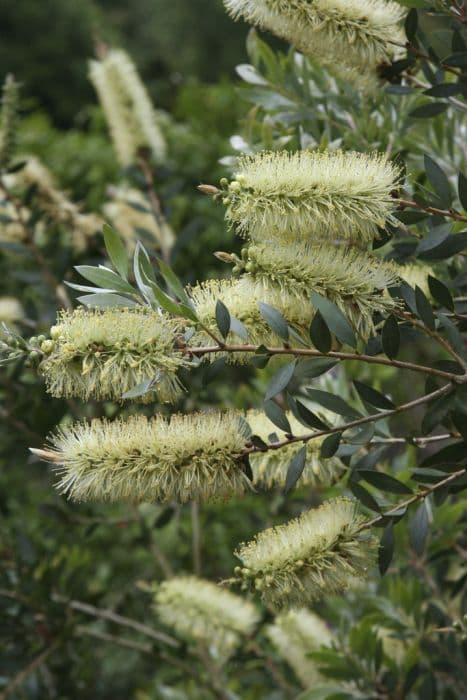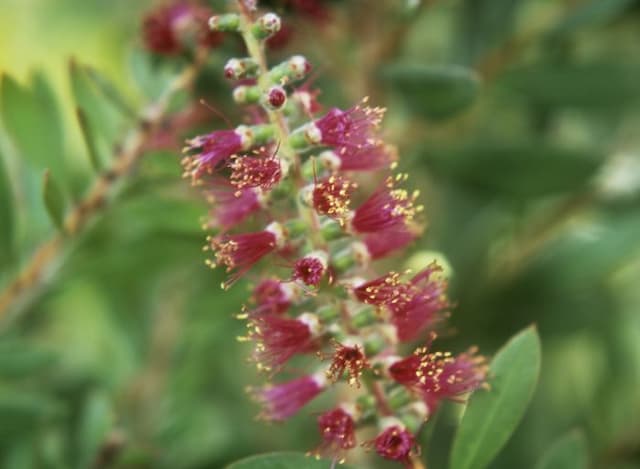New Zealand Myrtle Lophomyrtus × ralphii Black Pearl = 'Yanearl'
![New Zealand myrtle [Black Pearl]](/_next/image?url=https%3A%2F%2Fplants-admin.emdemapps.com%2Fimages%2Fplants%2F%2Fimages%2F604b53688d37e.png&w=3840&q=75)
ABOUT
Lophomyrtus × ralphii 'Black Pearl', commonly known as Black Pearl, has a striking appearance characterized by its stunning foliage, which is the plant's most captivating feature. The leaves are a glossy, deep purple to almost black color that shimmer in the sunlight, providing a dramatic contrast to greener plants in a garden setting. The foliage of the Black Pearl is dense and can sometimes show a mix of green, bronze, or red tones, especially on new growth or when the plant is in a transitional stage between seasons. Throughout the warmer months, small, star-shaped flowers bloom, adding to the visual interest of Black Pearl. These flowers are typically white or pink, which provides a delicate contrast against the dark foliage. Once the flowering season concludes, the plant may produce small, round berries that hold a similar hue to the leaves, though berries are not always a guaranteed feature. The overall texture of Black Pearl is bushy and lush, with leaves appearing in clusters that contribute to a full, compact appearance. The leaves themselves are ovate to lance-shaped, with a certain degree of pointiness at the tips, and they may exhibit slight undulations along the edges, giving the plant additional texture. With its richly colored leaves and adaptive use in landscaping as a statement piece or a background plant, Black Pearl is often admired for its ornamental value and ability to add depth and contrast to a garden setting.
About this plant
 Names
NamesSynonyms
NZ Myrtle, Black Pearl Mirror Plant, Black Pearl Lophomyrtus.
Common names
Lophomyrtus × ralphii Black Pearl = 'Yanearl'.
 Toxicity
ToxicityTo humans
Lophomyrtus × ralphii 'Black Pearl' is not widely documented as a toxic plant to humans. There are no specific symptoms of poisoning associated with this plant because it is not commonly known to be poisonous. However, as with many ornamental plants, it is advisable to avoid ingesting any parts of the plant because they can potentially cause gastrointestinal discomfort or allergic reactions in sensitive individuals.
To pets
Lophomyrtus × ralphii 'Black Pearl' does not have a well-documented toxicity profile for pets such as cats and dogs. Since comprehensive information on its toxicity to pets is not readily available, it is generally recommended to prevent pets from ingesting plants that have not been confirmed as safe. If ingested by pets, watch for signs of gastrointestinal upset such as vomiting or diarrhea, and contact a veterinarian if any concerning symptoms develop.
 Characteristics
CharacteristicsLife cycle
Perennials
Foliage type
Evergreen
Color of leaves
Mixed
Flower color
Pink
Height
5 feet (1.52 meters)
Spread
5 feet (1.52 meters)
Plant type
Shrub
Hardiness zones
9
Native area
New Zealand
Benefits
 General Benefits
General Benefits- Decorative Foliage: Lophomyrtus × ralphii Black Pearl has dark purple, almost black leaves, which add a striking contrast to green-dominated landscapes.
- Adaptability: It can adapt to a range of soil types, provided they are well-drained.
- Drought Tolerance: Once established, it can withstand periods of dryness, which makes it suitable for xeriscaping.
- Compact Size: With its moderate growth habit, it is well-suited to small gardens and spaces.
- Low Maintenance: Requires minimal pruning and can be easily maintained compared to other garden plants.
- Versatility in Landscaping: It can be used for hedging, specimen planting, or in mixed borders due to its attractive texture and color.
- Wildlife Attraction: The plant can attract birds and beneficial insects, providing ecological benefits to the garden.
- Seasonal Interest: It bears small white or pink flowers, adding seasonal interest and variety to the garden.
 Medical Properties
Medical PropertiesThis plant is not used for medical purposes.
 Air-purifying Qualities
Air-purifying QualitiesThis plant is not specifically known for air purifying qualities.
 Other Uses
Other Uses- Lophomyrtus 'Black Pearl' can be used as a natural dye source, as the dark foliage may produce unique color shades on fabrics.
- The dense foliage can provide a sound barrier in urban gardens, reducing noise pollution.
- Its sturdy branches can be shaped into living sculptures or topiaries in ornamental gardens.
- When dried and treated, branches of the 'Black Pearl' can be used for crafting, such as in wreath making.
- Leaves of the Lophomyrtus 'Black Pearl' can be used for educational purposes, such as teaching plant identification techniques or botanical illustration.
- Its contrasting leaf color can be used in color therapy gardens, as dark colors are said to provide emotionally grounding effects.
- The plant can be used in themed gardens, such as 'gothic' or 'dark beauty' gardens, due to its unique dark foliage.
- Cuttings from this plant can serve as an interesting addition to floral arrangements, providing a dark backdrop for brighter flowers.
- The dense growth habit can provide refuge and nesting sites for small urban wildlife, such as birds and beneficial insects.
- Bonsai enthusiasts may use Lophomyrtus 'Black Pearl' in their art, as it has an attractive leaf structure and can be trained into miniature tree forms.
Interesting Facts
 Feng Shui
Feng ShuiThe Lophomyrtus x ralphii 'Black Pearl' is not used in Feng Shui practice.
 Zodiac Sign Compitability
Zodiac Sign CompitabilityThe Lophomyrtus x ralphii 'Black Pearl' is not used in astrology practice.
 Plant Symbolism
Plant Symbolism- Mystery: The dark foliage of the Lophomyrtus × ralphii 'Black Pearl,' commonly known as Black Pearl, often symbolizes mystery due to its deep, almost black leaves.
- Rare Beauty: Because of its unique appearance and less common occurrence, Black Pearl can represent rare or unconventional beauty.
- Elegance: The sophisticated look of the plant, with its shiny leaves, can signify elegance in the plant world.
- Contrast: The stark contrast between the dark leaves and any brightly colored flowers or lighter foliage around it can symbolize the importance of contrast in life.
- Adaptability: As a hybrid plant, Black Pearl can symbolize adaptability and the blend of different characteristics to create something new and resilient.
 Water
WaterNew Zealand Myrtle should be watered thoroughly whenever the top inch of soil feels dry to the touch, which typically means once every week or two, depending on environmental conditions. Use room temperature water and apply it directly to the soil until it begins to drain from the bottom of the pot, indicating the soil is saturated. In general, providing about 16 to 32 ounces of water should be sufficient for a medium-sized pot. During the winter months, reduce watering as the plant's growth slows down. It's crucial to avoid overwatering to prevent root rot.
 Light
LightNew Zealand Myrtle thrives best in a spot with bright, indirect light. It can handle some direct morning sunlight but should be protected from the harsh afternoon sun to avoid leaf scorch. An east or west-facing window would be an ideal location for this plant, providing it with the light it needs without exposing it to excessive direct sunlight.
 Temperature
TemperatureNew Zealand Myrtle prefers temperatures between 65-75°F for optimal growth and can tolerate a minimum temperature of about 50°F. It should be protected from extreme temperatures and cold drafts, as temperatures below 50°F can damage the plant. It's important to provide a consistent temperature range to avoid stress to the plant.
 Pruning
PruningPruning New Zealand Myrtle is important to maintain its shape and encourage bushier growth. It should be pruned in the late winter or early spring before new growth begins. Remove any dead, damaged, or diseased branches and trim back leggy stems to promote fuller growth. It's generally only necessary to prune once per year, but light trimming can be done throughout the year to shape the plant as desired.
 Cleaning
CleaningAs needed
 Soil
SoilLophomyrtus 'Black Pearl' thrives in well-draining soil with high organic matter. A mix of peat, pine bark, and coarse sand or perlite is ideal. Aim for a soil pH of 5.0 to 6.5 to ensure healthy growth.
 Repotting
RepottingLophomyrtus 'Black Pearl' should be repotted every 2-3 years to refresh the soil and accommodate root growth. Smaller, fast-growing specimens may need repotting annually.
 Humidity & Misting
Humidity & MistingLophomyrtus 'Black Pearl' favors moderate to high humidity levels, ideally between 40% and 60%. Avoid dry air conditions to maintain healthy foliage development.
 Suitable locations
Suitable locationsIndoor
Place in bright, indirect light and ensure high humidity.
Outdoor
Plant in partial shade, shelter from strong winds.
Hardiness zone
8-11 USDA
 Life cycle
Life cycleLophomyrtus x ralphii 'Black Pearl' begins its life as a seed, which upon germination, develops into a seedling with a simple root system and a set of initial leaves. As the plant grows, it enters the juvenile phase, where it establishes more robust roots and foliage and develops its characteristic dark purple to nearly black leaves. During the mature phase, 'Black Pearl' forms a woody structure and can reach up to 3-4 meters in height, and it starts to produce small, star-shaped, white or pale pink flowers during the summer. After pollination, typically by insects, the flowers give way to crimson-purple berries that contain seeds for reproduction. As a perennial, 'Black Pearl' can live for many years, going through annual cycles of flowering and fruiting. Eventually, the plant reaches the senescent stage, where growth and reproductive capacity decline until the plant dies.
 Propogation
PropogationPropogation time
Spring-Early Summer
The most popular method of propagation for the Lophomyrtus × ralphii 'Black Pearl', commonly known as New Zealand myrtle, is through semi-hardwood cuttings. This typically occurs during the warmer months, from late spring to early summer, when active growth ensures a higher success rate. To propagate, select a healthy stem with several leaves and cut a 4 to 6-inch (about 10 to 15 centimeters) section just below a leaf node, where the concentration of growth hormones is higher. Remove the bottom half of the leaves to expose the nodes and dip the cut end into rooting hormone powder to encourage root development. Then, plant the cutting in a well-draining potting mix, ensuring at least one or two nodes are buried where roots can form. Keep the soil consistently moist but not waterlogged and place the cutting in a bright, indirect light area until it establishes a strong root system, which may take several weeks. Once rooted, the new plant can eventually be transplanted to a more permanent location in the garden or container.









